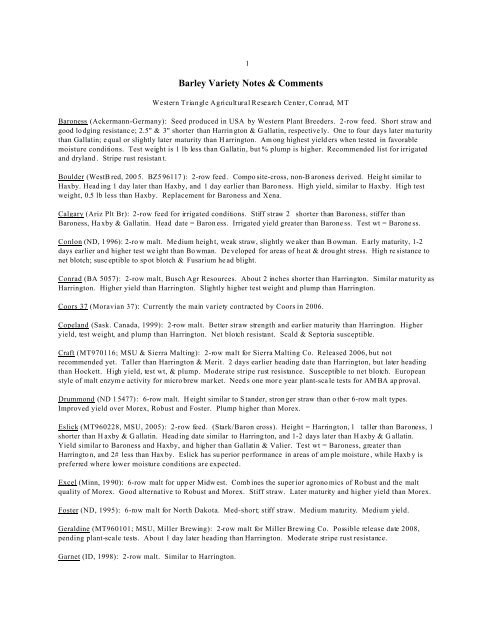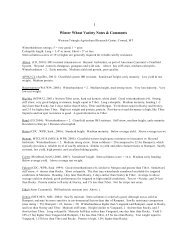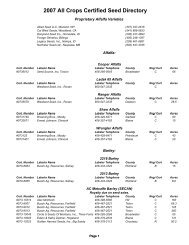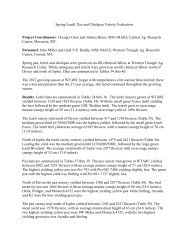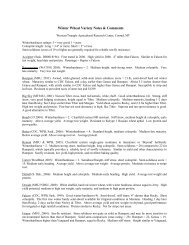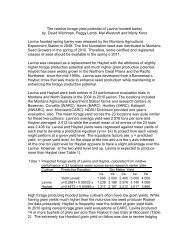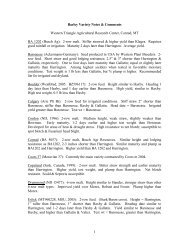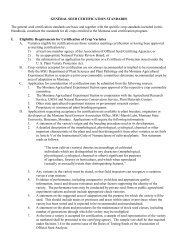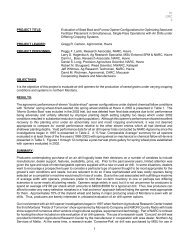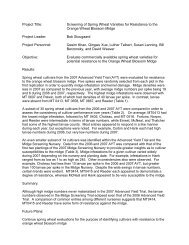Barley Variety Notes & Comments
Barley Variety Notes & Comments
Barley Variety Notes & Comments
Create successful ePaper yourself
Turn your PDF publications into a flip-book with our unique Google optimized e-Paper software.
2Harrington (Sask. Can): 2-row malt. Medium height; medium weak straw. Late maturity. Sensitive to hot dryareas; yields good in moist areas. Can sprout or germinate (internal falling number) at a lower moisture content thanother varieties. Sweating in the b in can be enough to ruin germination. Susceptible to skinning unless carefullythreshed.Haxby (MSU 2002, M T950 186): 2-ro w feed. 3 inches taller and two days earlier than Baroness. Yield is eq ual toBarone ss, and is among highest yielders in Triangle Area. Highest test weight of all varieties. High feed quality.Non-Baroness derived, providing good diversity. Haxby has superior yield performance in lower moistureconditions, while Eslick has a yield advantage in high moisture conditions.Haybet (MSU ): 2-row, hoo ded hay barley. Later to mature than Horsford, and higher forage yield. Similar toHorsford for grain yield, which is low. Harvest between heading stage and 5 d ays post-head ing for highest protein.Caution: any cereal grain grown for hay should be tested for nitrate level prior to cutting. 1/ see footnote.Hays (MSU , 2004): M T981 060. Hooded 2-row. Shorter than Haybet and more resistant to lodging. Higher grainyield than Haybet (similar to Harrington). Test wt = Haybet, and 2# less than Harrington. Higher forage yield thanHaybet and Westford (8%). Harvest between heading stage and 5 days post-heading for highest protein. Caution:any cereal gra in grown for hay should be tested for nitrate level prior to cutting. 1/ see footnote.Hockett (MSU , MT9 10189 ): 2-row dryland malt. Possible release d ate 2008 , pending plant-scale test results.Experimental 2-row malt for dryland. 4 days earlier than Harrington, and retains plump on dryland much better thanHarrington. 5 bu/a highe r yield than Harrington. Very susceptible to stripe rust.Kendall (Can): 2-row malt. High irrigated yield.Lacey (M98, MN 1 999): 6-ro w malt. Intended to replace Robust. Height interm ediate between Rob ust & Stander.Lodging resistance greater than Robust, but less than Stander.Legacy (Busch Ag 2978; 6B932978): 6-row malt. 2 to 4 inches taller than Harrington. Higher yield than Morexand Robust, but lower than Harrington. Has 30% resistance to vomatoxin. Very susceptible to stripe rust.Manley (TR 409) (Canada): 2-row. Slightly stiffer strawed and three days later than Harrington, (approx. Klagesmaturity); longer shelf life than Harrington - does not lose its germination as bad. May replace H arrington inCanada; but only in high rainfall, stripe rust areas.Merit (Busch Ag): 2-row malt. Late maturing, too late for dryland. Lodges easier than 1202 and Harrington, butyields higher. V ery high diastatic power for excellent malting ability. Net blotch resistance, and moderate Scaldresistance.Merlin, Westbred (WPB): Waxy seed, semidwarf. Better yield and lodging resistance than Waxbar, but quality notaccepted by Japan m arkets yet.Metcalfe (Manitoba Canada, 1994): 2-row malt. Possible replacement for Harrington. Medium straw strength.Higher yield, test weight and p lump than H arrington. Sim ilar protein as H arrington. M edium-late, slightly earlier tohead than Harrington. Moderate resistance to spot-form net blotch. Susceptible to scald and Septoria.Morex (Minn, 1978): 6-row malt. Tall; medium straw strength. Early maturity. Shatters readily - swathingadvised. Agronomically the worst malting barley on the list. Excel may be a better choice.Rawson (ND19119 ???): 2-row feed. Medium height & straw strength. Higher yield and 20% larger seed thanConlon. MR to spot & net blotch. Adapted to western N Dakota.Robust (Mn, 19 83): 6-row malt. Tall; medium straw strength. Med ium maturity. The 1992 Robust crop inMinnesota did not malt due to dormancy for unknown reasons. Growers therefore switched to 'Stander' in 1993.
Stander (M-64, M inn, 1993): 6-row malt for upper Midwest. Med-short straw, stiffer than other 6-row malt types.Medium-late maturity. Better yield stability and kernel-plump than Excel, but Excel seems to be preferred bygrowers.Stellar (ND16301, 2 005): 6-ro w malt. Medium-short. G ood straw strength and widely adapted across N orthDakota. Medium maturity. High p lump and low protein. Excellent malt quality. Mo derate spo t-blotch resistanc e.Net-blotch susceptible.3Stockford (WestBred, 2005). 2-row hooded hay barley. Height is 2 taller than Hays. Heading is 2 days earlierthan Hays. Forage yield is similar to Hays and Haybet. Harvest between heading stage and 5 days post-heading forhighest protein. Caution: any cereal grain grown for hay should be tested for nitrate level prior to cutting. 1/ seefootnote.Tradition (Busch A g, BA6B 95-248 2): 6-row malt. Stiffer straw than Legacy, good lodging re sistance. Higher yieldthan Legacy. Higher test weight and plum p than Lega cy. Very susceptible to stripe rust.Valier (MSU 1999): 2-row feed. Lewis/Baroness cross 10% better feed efficiency (rumenal digestibility) and 10%better ADG in cattle. Agronomically superior to Gallatin and Lewis, but less than Baroness. Better head extensionout of boot than Baroness.Waxbar, Westbred (WPB): W axy barley grown under contract in 1994 & 1995 for export to Japan. Standard heightand fairly late to mature. See Merlin.Westford, Westbred (WPB): 6-row hooded hay barley. Maturity considerably later than Horsford and Whitford,allowing for greater forage production. Seed yield low (similar to Horsford). Hay yields considerably higher thanHorsford. Harvest between heading stage and 5 days post-heading for highest protein. Hooded barleys aresometimes vulnerable to ergot, but the amount is slight. Caution should be taken to avoid high nitrate levels whenusing any small grain as a forage. Test forage for nitrate before the crop is harvested. 1/ see footnote.Xena (WPB bz594-19): baroness/stark cross. 2-row feed. Two inches taller and better boot emergence thanBaroness. Lodging resistance equal to Baroness. Late maturity, similar to Baroness. Better adapted to dryland thanBaroness, (higher test wt and plump than Baroness on dryland). Equal or better yield than Baroness on dryland.1/ Nitrates in hay: Oats have the highest nitrate levels, 6-row barleys have the next highest, and 2-row barleys ranklower nitrates. Winter wheat hay tends to be safer than spring grains for nitrates because the earlier seasonaldevelopment allows the winter wheat to escape heat stress better. N itrates decrease during grain filling, but indrought conditions, nitrates in spring grains may be high all season, unless irrigation is available.


